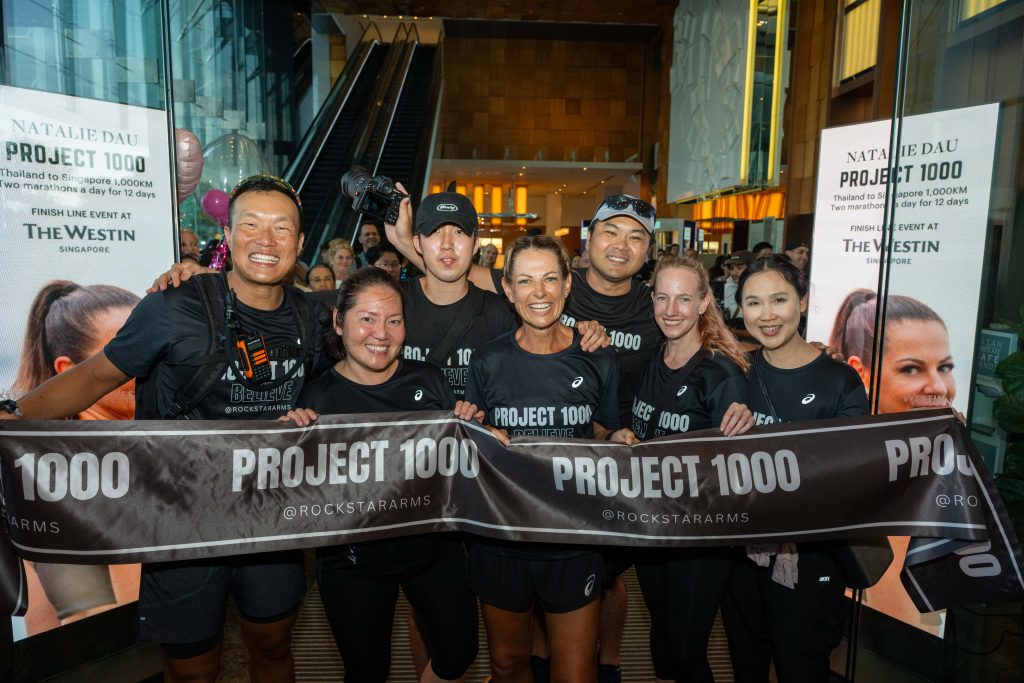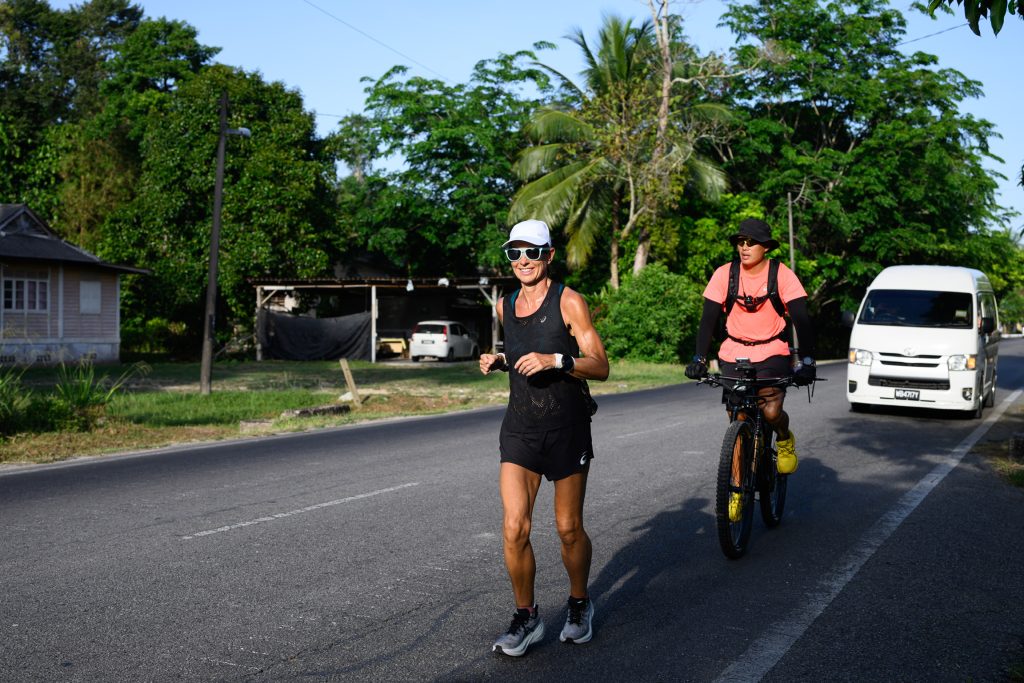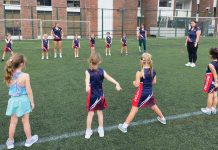
Earlier this month, ANZA member Natalie Dau successfully completed her record-breaking Project 1000 solo charity run of 1000km from Thailand to Singapore in an incredible 12 days. Beginning her journey in Hat Yai on May 25, Natalie traversed the entire length of Malaysia, completing the equivalent of two marathons a day, and concluded her journey in Singapore on Global Running Day, June 5.
Hundreds gathered at The Westin Singapore to celebrate her historic achievement, which earned a place in the Singapore Book of Records for the “Fastest 1000 km Thailand-Singapore Ultramarathon.” Her Guinness World Record title for the “Fastest Crossing of Peninsular Malaysia on Foot” is now pending certification. Through Project 1000, Natalie also raised funds to support underprivileged women and girls through GRLS, a global charity and part of Women Win, which works to elevate women and girls worldwide through sport and exercise.
Many ANZA members joined Natalie, 52, upon her arrival in Singapore, and our very own ANZA President Megan Kinder was at the finish line to conduct an interview with her. A few days afterwards, ANZA was lucky to chat with Natalie to learn more about the project and how she (and her poor feet!) were feeling.
1. Congratulations on your incredible Project 1000 achievement! What inspired you to undertake this epic race from Thailand to Singapore?
I always try to push myself toward a new challenge, and at some point last year, I was thinking about what to do next after a series of ultramarathons. I thought that 1000 km could be a real milestone to go for. Given Singapore has been my home for the last 20 years, I knew I wanted to do this in this region and part of the world, on home territory.
2. Please share more about the charity you were supporting with this race …
Supporting women and girls to feel empowered, positive about their bodies, and engaged with physical activity and sport is a cause very close to my heart. The connection to mental health and overall well-being is so important. It was crucial to me that funds raised through Project 1000 contribute directly to underprivileged girls and women, so I partnered with GRLS, a global charity and part of Women Win, which works to elevate women and girls worldwide through sport and exercise.
3. How did you prepare both mentally and physically for such a grueling long-distance race?
For the most part, I stuck to my normal training routine, which means running approximately 100-150 km every week. As I got closer to the start of the Project 1000 run, I started doing two runs a day, with one being later in the morning under peak heat and sun.

4. What kind of support team did you have during the race, and how crucial were they to your success?
Arthur is just incredible, and I could not have done this without him. He was the first person I talked to about the project, and without hesitation, he was in. He helped with the overall route and logistics planning, ensured I was getting proper nutrition, hydration, and care throughout the run, and he cycled the entire 1000 km by my side. My crew – Joan, Elizabeth, Mook, Jaems, and Ian – were outstanding and integral to the project. They provided PR and social media support, a film and photography team, and logistics support for Thailand specifically. Everyone came together with such heart and trust in each other and the goal we were working towards, wearing many hats to ensure we succeeded.
5. Can you describe the route you took and any significant landmarks or challenges you remember?
Starting the run in Thailand, we had police and military escorts for three days, which were incredibly helpful for both navigation and peace of mind. However, the extreme heat and rough road conditions led to flat tires on two of our support vans, causing some complications. In Malaysia, we also had a few run-ins with wild dogs chasing me, and I had to jump into the support van until we moved ahead to safety.
6. You stopped off at some significant spots as you ran – can you share some highlights?
In Thailand, we began the run at Hat Yai University and stopped along the way to visit several schools and speak with students. It was wonderful hearing from them and getting to talk about their passions and dreams. I was so touched by all that they shared and the warm welcome they gave us. As we moved through Malaysia, people would often give a friendly wave or come to the side of the road to hand me a bottle of water. These little moments were touching and a lovely reminder of the goodness of humanity. We really are all the same, no matter where we come from.
7. What were the most difficult moments during the race, and how did you overcome them?
The conclusion of the first day was really difficult. I ran quite fast and hard that day, and my hip started bothering me. It was a scary moment because it was so early in the run to have an injury. At that point, we called my physio, Jenny, who recommended a new strategy to take some pressure off the injury: slowing down the pace and having more frequent rest intervals throughout the day. We agreed that it was better to view each day as one long consistent run, keeping eyes on the long-term goal.
The heat was also incredibly brutal, so we started our days much earlier to maximize the cooler morning hours. I also came down with a UTI that persisted for seven days and turned into rhabdomyolysis. I was in a lot of pain and peeing blood. Despite this, I never considered giving up. Too many people were invested in this and supporting me, and I couldn’t let them down.
8. How did you manage nutrition and hydration during the race to maintain your energy levels? Where and how well did you sleep?
There were some foundations to my nutrition that we kept consistent throughout, like having AG1 every morning, followed by coffee and carbohydrates like a simple jam sandwich, getting in as many calories as possible before it got too hot. I also took electrolytes and sodium frequently. During the run, it’s hard for me to keep much down, but it was crucial to stay hydrated, especially in the heat. I drank water and other sports beverages and energy drinks throughout the day, usually with my team passing them to me through the van window while I was running. We stopped each night to sleep at a hotel along the way, but only for a few hours. I generally went to bed around 9 pm and then got up before midnight to start running around 12:30 or 1 am.
 9. How emotional was it for you when you entered Singapore and ran to the finish line?
9. How emotional was it for you when you entered Singapore and ran to the finish line?
It was such an overwhelmingly beautiful and emotional moment, and a bit surreal. Seeing so many friends, family, and fellow runners gathered there to welcome me back just meant the world to me. Project 1000 has always been about community, and it really felt so at the finish line.
10. Achieving Singapore Book of Records status is a massive accomplishment. How do you feel about this?
Yes, it’s quite exciting. Achieving a record was never my primary goal, but I definitely appreciate this, and it’s nice to have the official recognition. The title for the Singapore Book of Records is the “Fastest 1000 km Ultramarathon from Thailand to Singapore.” This title will also be verified by the Australia Book of Records.
11. We understand you are channelling a Guinness Book of Records title as well?
Yes, that’s right! I’ve applied for the Guinness Book of Records title for the “Fastest Crossing of Peninsular Malaysia on Foot.” I’ve just finished submitting all of the paperwork and evidence and expect this to be certified soon.
12. How have you celebrated since?
Following the initial excitement, I’ve been relishing time with my family and focusing on rest and recovery. My parents came for a surprise visit, so I’m spending as much time with them as possible. I’ve been to the doctor’s for tests to ensure my body is okay and to understand what I need to do in the recovery phase, which includes regular IV drips and visits to Hello Physio. We’re also planning a team dinner to get together and celebrate.
13. What message do you hope to send to your social media followers and aspiring athletes through this achievement?
I want everyone to believe in themselves and not feel limited by what others may think or societal expectations. It may not be easy, and there may be many challenges along the way, but we are all stronger and more capable than we realise. Dream bigger and believe in yourself!
14. Any personal message to the ANZA community – any words of wisdom to encourage members to join our many sports groups?
Thank you all for the great support! It has meant a lot throughout this journey, and I really appreciate it. I look forward to joining you in a run sometime soon!
15. What’s next for you? Are there any other races or challenges you are planning?
I’m looking forward to taking a holiday and relaxing with my family later this month, and then I’ll be gearing up for the Sydney Marathon coming up in mid September.








